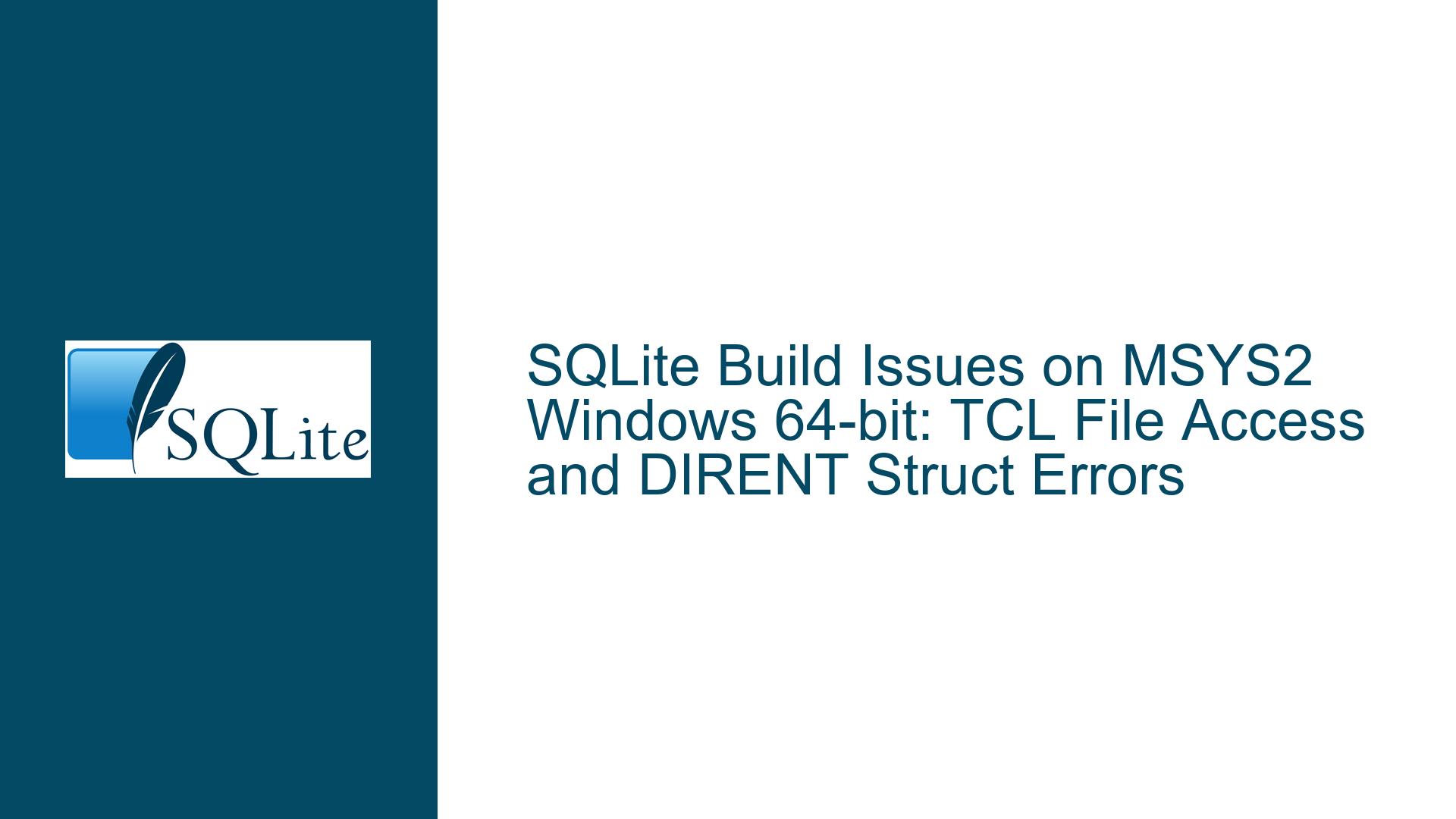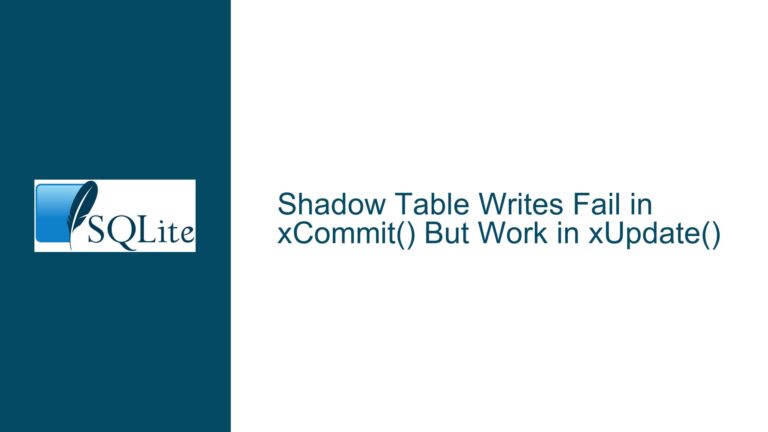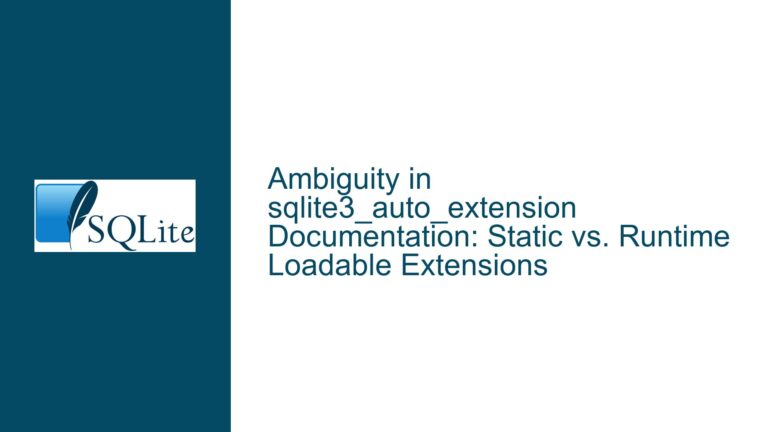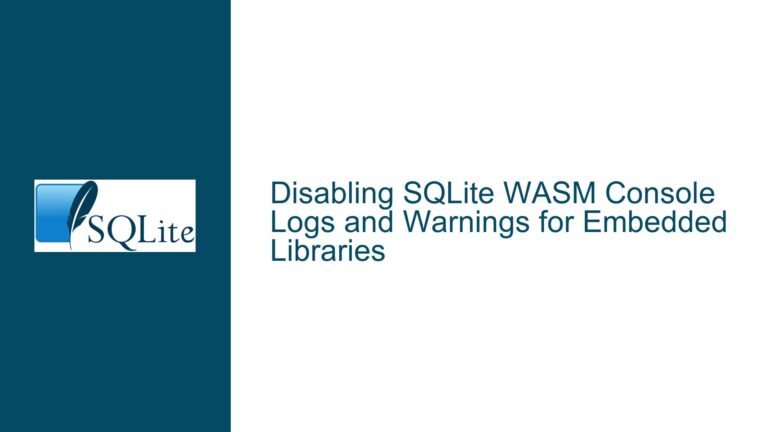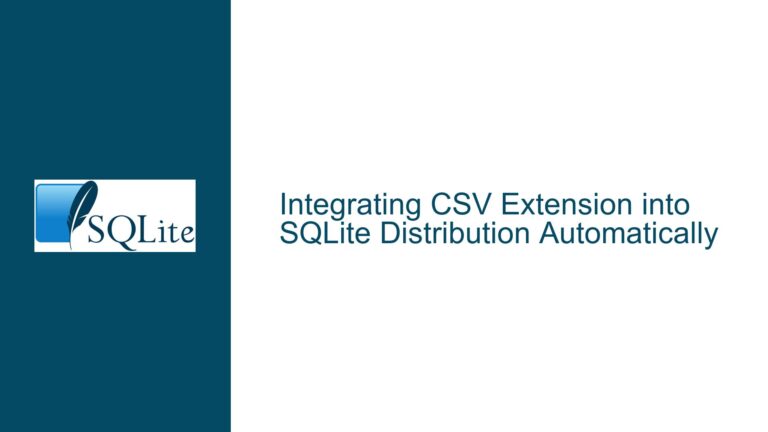SQLite Build Issues on MSYS2 Windows 64-bit: TCL File Access and DIRENT Struct Errors
TCL Script Fails to Open SQLite Source Files in MSYS2 Environment
When attempting to build SQLite on a Windows 64-bit system using MSYS2 and MinGW64, a common issue arises where the TCL script (mkccode.tcl) fails to open SQLite source files such as sqlite3.c. The error message indicates that the file cannot be found, even though the file exists and the path provided to the TCL script is correct. This issue is particularly prevalent when generating source code for executables like sqlite3_analyzer.c.
The error occurs during the execution of the mkccode.tcl script, specifically when the script attempts to open a file using the open command. The error message typically reads: ": no such file or directory while executing 'open $path rb'". This suggests that the TCL interpreter, despite being correctly invoked, cannot access the file due to an underlying issue with the MSYS2 environment or the way paths are handled.
One of the key challenges here is the interaction between the MSYS2 environment, the Windows file system, and the TCL interpreter. MSYS2 uses a POSIX-like file system structure, which can sometimes conflict with the native Windows file system paths. For example, the path /c/sqlite/tool/mkccode.tcl is a POSIX-style path, but the TCL interpreter might be expecting a Windows-style path (e.g., C:\sqlite\tool\mkccode.tcl). This discrepancy can lead to the "no such file or directory" error.
Another potential issue is the handling of file permissions within the MSYS2 environment. Even if the file exists and the path is correct, the TCL interpreter might not have the necessary permissions to open the file. This can happen if the file is located in a directory that requires elevated privileges or if the file itself has restrictive permissions.
Interrupted File Access and DIRENT Struct Definition Errors
The second issue encountered during the build process involves the compilation of testfixture.exe, which results in an error related to the DIRENT struct. The error message sqlite/ext/misc/fileio.c:701:18: error: invalid use of undefined type 'struct DIRENT' indicates that the compiler cannot find the definition of the DIRENT struct, which is typically used for directory operations.
The DIRENT struct is part of the POSIX standard and is used to represent directory entries. However, on Windows, the equivalent functionality is provided by the WIN32_FIND_DATA structure, which is part of the Windows API. The error suggests that the build process is attempting to use POSIX-specific code on a Windows system without the necessary adaptations.
This issue is closely related to the configuration of the build environment. When building SQLite on Windows using MSYS2 and MinGW64, it is essential to ensure that the correct configuration flags are used to account for the differences between POSIX and Windows systems. Specifically, the build process should be configured to use the Windows SDK for directory operations, and the appropriate source files (such as test_windirent.c) should be included to provide the necessary Windows-specific implementations.
The test_windirent.c file is a custom implementation of the POSIX DIRENT struct for Windows systems. It provides the necessary definitions and functions to allow POSIX-compatible directory operations on Windows. However, if this file is not included in the build process or if the build configuration does not account for the differences between POSIX and Windows, the compiler will fail to find the DIRENT struct, resulting in the observed error.
Configuring MSYS2 Environment and Implementing Windows-Specific Build Flags
To resolve the issues described above, it is necessary to carefully configure the MSYS2 environment and implement the appropriate build flags for SQLite on Windows. The following steps outline the process for addressing both the TCL file access issue and the DIRENT struct error.
Configuring TCL Script Execution in MSYS2
The first step in resolving the TCL file access issue is to ensure that the TCL interpreter can correctly access the SQLite source files. This involves verifying the file paths and ensuring that the TCL script is executed in a way that is compatible with the MSYS2 environment.
One approach is to modify the mkccode.tcl script to explicitly convert POSIX-style paths to Windows-style paths before attempting to open the files. This can be done using the file normalize command in TCL, which converts a path to its canonical form. For example, the following code snippet can be added to the mkccode.tcl script to ensure that the paths are correctly interpreted:
set path [file normalize $path]
if {[catch {open $path rb} in]} {
puts stderr "Error: Could not open file $path"
exit 1
}
This modification ensures that the path is correctly converted to a Windows-style path before the file is opened. Additionally, it is important to ensure that the TCL interpreter has the necessary permissions to access the file. This can be done by running the MSYS2 shell with elevated privileges or by adjusting the file permissions using the chmod command.
Implementing Windows-Specific Build Flags and Source Files
To resolve the DIRENT struct error, it is necessary to configure the build process to use the Windows SDK and include the appropriate source files for Windows-specific implementations. This involves modifying the SQLite build configuration to account for the differences between POSIX and Windows systems.
The first step is to ensure that the Windows SDK is correctly installed and accessible from the MSYS2 environment. This can be done by setting the appropriate environment variables, such as INCLUDE and LIB, to point to the Windows SDK directories. For example, the following commands can be added to the MSYS2 shell configuration file (~/.bashrc or ~/.bash_profile) to set the environment variables:
export INCLUDE="/c/Program Files (x86)/Windows Kits/10/Include/10.0.19041.0/ucrt"
export LIB="/c/Program Files (x86)/Windows Kits/10/Lib/10.0.19041.0/ucrt/x64"
Next, the SQLite build configuration should be modified to include the test_windirent.c file and to use the appropriate build flags for Windows. This can be done by adding the following flags to the configure command:
./configure --enable-windirent --with-tcl=/c/msys64/mingw64/lib/tcl8.6
The --enable-windirent flag ensures that the test_windirent.c file is included in the build process, providing the necessary Windows-specific implementations for directory operations. The --with-tcl flag specifies the location of the TCL library, ensuring that the TCL interpreter is correctly linked during the build process.
Verifying the Build Configuration and Resolving Remaining Issues
After implementing the above changes, it is important to verify that the build configuration is correct and that all necessary files and libraries are accessible. This can be done by running the configure script and checking for any errors or warnings. If the configuration is successful, the next step is to run the make command to build SQLite.
During the build process, it is important to monitor the output for any errors or warnings related to file access or the DIRENT struct. If any issues are encountered, they should be addressed by revisiting the configuration steps and ensuring that all necessary files and libraries are correctly included.
In some cases, it may be necessary to manually modify the SQLite source code to account for specific issues related to the MSYS2 environment. For example, if the DIRENT struct error persists, it may be necessary to add additional conditional compilation directives to the fileio.c file to ensure that the correct definitions are used on Windows systems. This can be done by adding the following code snippet to the fileio.c file:
#ifdef _WIN32
#include "test_windirent.h"
#endif
This ensures that the test_windirent.h file is included when building on Windows, providing the necessary definitions for the DIRENT struct.
Conclusion
Building SQLite on a Windows 64-bit system using MSYS2 and MinGW64 can be challenging due to the differences between POSIX and Windows systems. However, by carefully configuring the MSYS2 environment, implementing the appropriate build flags, and modifying the SQLite source code as needed, it is possible to resolve the issues related to TCL file access and the DIRENT struct. The key is to ensure that the build process is correctly adapted to account for the specific requirements of the Windows platform, while still maintaining compatibility with the POSIX-based tools and libraries used in the MSYS2 environment.
